Solution Manual for College Algebra 8th
Edition Aufmann Nation ISBN
12854347739781285434773
Full link download:
https://testbankpack.com/p/solution-manual-for-college-algebra-8th-editionaufmann-nation-isbn-1285434773-9781285434773/
Chapter 2 Functions and Graphs
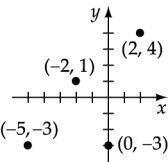
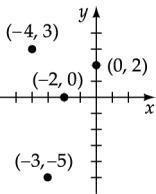
Section 2.1 Exercises
Plot the points:
Plot the points:
a. Find the decrease: The average debt decreased between 2006 and 2007, and 2008 and 2009
b. Find the average debt in 2011:
Increase between 2009 to 2010: 22.0 20.1 1.9
Then the increase from 2010 to 2011: 22.0 1.9 23.9 , or $23,900.
a. When the cost of a game is $22, 60 million games
Determine whether the ordered pair is a solution
2x + 5y = 16 ?
2(-2) +5(4)=16 ? -4 + 20=16
16 = 16 True
(–2, 4) is a solution.
Determine whether the ordered pair is a solution
Determine whether the ordered pair is a solution
b. The projected numbers of sales decreases as the price of this game increases.
c. .Create a table and scatter diagram:
R = p
N 8 8 80= 640
15 15 70=1050
22 22 60=1320
27 27 50=1350
31 31 40=1240 34 34 30=1020
36 36 20= 720 37 37 10= 370
The revenue increases to a certain point and then decreases as the price of the game increases.

17=27 +12+ 2
17 = 41 False
(–
3, 17) is not a solution
Determine whether the ordered pair is a solution
x 2 + y 2 = 169 ?
=169 ? 4 +144=169
= 169 False (
2, 12) is not a solution
Find the distance: (6, 4), (–8, 11)
Find the distance: (–5, 8), (–10, 14)
= (-10-(-5))2 + (142
2 + (6)2
16. Find the distance: ( 125, 20) , (6, 2 5)
d = (6- 125)2 + (2 52
(6-5 5)2 + (2 5 -2 5)2 25+ 36
Find the distance: (–4, –20), (–10, 15)
= (-10-(-4))2 + (15-(-20))2 2 + (35 2 36+1225 1261
Find the distance: (40, 32), (36, 20)
(6-5 5)2 = 6-5 5 =5 5-6
Note: for another form of the solution,
d = (6-5 5)2 36-60 5 +125 = 161-60 5
Find the distance: (a, b), (–a, –b)
Find
Thus (13, 5) is the other endpoint.
Thus ( 8, 28) is the other endpoint.
Find other endpoint: endpoint (–3, –8), midpoint (2, –7)
Thus (7, 6) is the other endpoint. è
Find the midpoint: (1.75, 2.25), (–3.5, 5.57) æ 2.25+5.57 ö
Find other endpoint: endpoint (5, –4), midpoint (0, 0) æ x + 5 y + (-4) ö
Find the midpoint: (–8.2, 10.1), (–2.4, –5.7)
æ -8.2 + (-2 4) 10.1+ (-5 7) ö
Thus ( 5, 4) is the other endpoint.
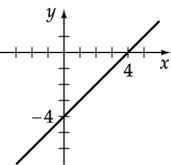
Graph the equation: 2 x + y = -1
Graph the equation: y = x 2 -
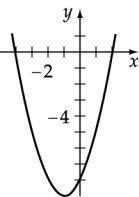
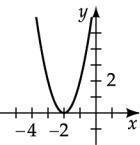
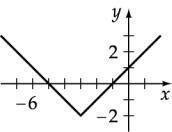
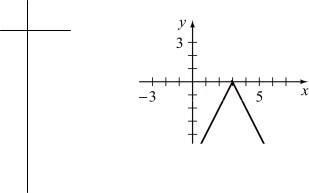

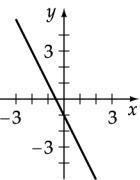
3
Graph the equation: y = 0 25x 2

Graph the equation: 3 x 2 + 2 y = -4
Graph the equation: y = 2 ( x -1)
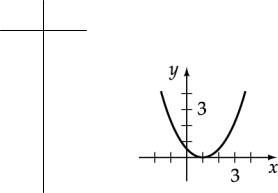
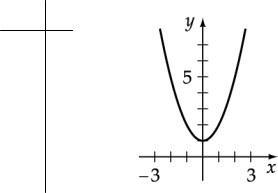
Graph the equation: y = -2 x -3

Graph the equation: y = x 2 - 2x -8
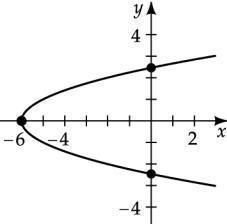
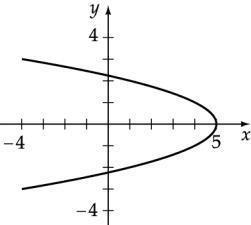
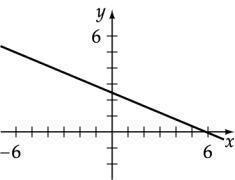
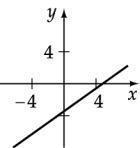

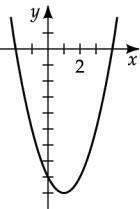
-2 0 0 -8
1 -9
Graph the equation: y = - x 2 + 2

Graph the equation: y = - x 2 -1
Find the x- and y-intercepts and graph: 2x + 5y = 12
For the y-intercept, let x = 0 and solve for y
3x - 4(0) = 15
x = 5, x-intercept: (5, 0)
Find the x- and y-intercepts and graph: x =2 + 5
For the y-intercept, let x = 0 and solve for y
= - y 2 + 5
y = 5, y-intercepts: (0,- 5) ,(0, 5)
For the x-intercept, let y = 0 and solve for x
= -(0)2 +5
x = 5, x-intercept: (5, 0)
Find the x- and y-intercepts and graph: x = 2 -6
For the y-intercept, let x = 0 and solve for y
y y
0 = y 2 -6
y = 6, y-intercepts: (0,- 6) ,(0, 6)
y = , 0,
2 (0)+5 y =12 12 æ 12ö ç ÷ 5 è 5 ø
For the x-intercept, let y = 0 and solve for x.
2x + 5(0) = 12
x = 6, x-intercept: (6, 0)
Find the x- and y-intercepts and graph: 3x - 4 y = 15
For the y-intercept, let x = 0 and solve for y
= 15
For the x-intercept, let y = 0 and solve for x.
For the x-intercept, let y = 0 and solve for x
=(0)2 -6
x = -6, x-intercept: (-6, 0)
Find the x- and y-intercepts and graph: x = y - 4
For the y-intercept, let x = 0 and solve for y
0 = y - 4
= 4, y-intercepts: (0,-4),(0, 4) For
the x-intercept, let y = 0 and solve for x.
x = 0 - 4
x = -4, x-intercept: (-4, 0)
Find the x- and y-intercepts and graph: x = 3 - 2
For the y-intercept, let x = 0 and solve for y
0 = y 3 - 2
y = 3 2, y-intercept: (0, 3 2)
For the x-intercept, let y = 0 and solve for x. =(0)3 -2
x = -2, x-intercept: (-2, 0)
Find the x- and y-intercepts and graph: x 2 + 2 = 4
For the y-intercept, let x = 0 and solve for y.
For the x-intercept, let y = 0 and solve for x
Intercept: (0, 0)
Find center and radius: x 2 + 2
center (0, 0), radius 6
Find center and radius: x 2 + 2
center (0, 0), radius 7
Find center and radius: ( x - 1)
center (1, 3), radius 7
Find center and radius: ( x - 2)
center (2, 4), radius 5
Find center and radius: ( x + 2)
25 center ( 2, 5), radius 5
= 36 = 49
+ ( y - 3)2 = 49
+ ( y - 4)2 = 25
Find center and radius: ( x + 3)2 + ( y + 5)2 =
121 center ( 3, 5), radius 11
Find center and radius: ( x - 8)2 2 ( 0 2 2 = 4 = 2, y-intercepts: ( 0,-2) , ( 0, 2) 1 1 4 center (8, 0), radius 2
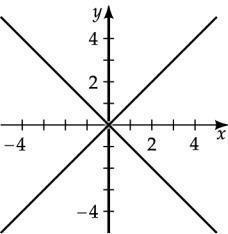
) +
For the x-intercept, let y = 0 and solve for x.
x 2 + ( 0 )2 = 4
x = 2, x-intercepts: (-2, 0) , ( 2, 0)
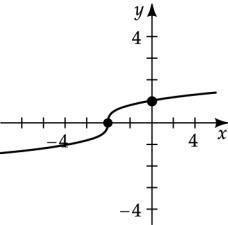
Find center and radius: x 2 + ( y - 12)2 = 1
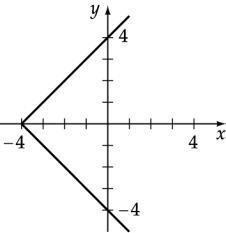
center (0, 12), radius 1
Find circle equation: center (4, 1), radius 2
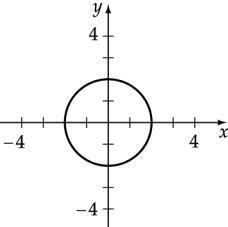
(x - 4)2 + ( y - 1)2 = 22
(x - 4)2 + ( y - 1)2 = 4
Find circle equation: center (5, –3), radius 4
(x - 5)2 + ( y + 3)2 = 42
(x - 5)2 + ( y + 3)2 = 16
Find the x- and y-intercepts and graph: 2 2
For the y-intercept, let x = 0 and solve for y
63. Find circle equation: center (1 2 , 1 4) , radius 5
Find circle equation: center (
2, 5), through (1, 7)
64. Find circle equation: center (0, 2 3) , radius11
Find circle equation: center (-2, 5) , diameter 10
65. Find circle equation: center (0, 0), through (–3, 4)
Find circle equation: center (0, 0), through (5, 12)
Since the diameter is 10, the radius is 5
The center is the midpoint of the line segment from (2, 3) to (–4, 11) æ ö
2 ø (x + 1)2 + ( y - 7)2 = 25
Find circle equation: endpoints (7, –2) and (–3, 5)
Find circle equation: center (1, 3), through (4, –1)
d = (-3 - 7)2 + (5- (-2))2 = 100 + 49 = 149 .
Since the diameter is 9 , the radius is 149 2
7
Find circle equation: center (7, 11), tangent to x-axis
Since it is tangent to the x-axis, its radius is 11.
x - 7)2 + ( y - 11)2 = 112
Find circle equation: center (–2, 3), tangent to y-axis
Since it is tangent to the y-axis, its radius is 2 (x + 2)2 + ( y - 3)2 = 22
Find center and radius: x 2 + y 2 - 6x + 5 = 0
Find the x- and y-intercepts and graph: x + y = 4 Intercepts: (0, 4), ( 4, 0)
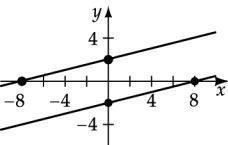
Find the x- and y-intercepts and graph: x - 4 y = 8 For the y-intercept, let x = 0 and solve for y. 0- 4 y = 8

4 y = 8 = 2, y-intercepts: (0,-2),(0, 2) For the x-intercept, let y = 0 and solve for x
x - 4(0) = 8
x = 8, x-intercepts: (-8, 0),(8, 0)
Find the formula:
P2. D = {-3,-2,-1, 0, 2}
R = {1 , 2, 4, 5}
P3.
Section
Exercises
Write the domain and range. State whether a relation.
Domain: {–4, 2, 5, 7}; range: {1, 3, 11}
Yes. The set of ordered pairs defines y as a function of since each x is paired with exactly one y
Write the domain and range. State whether a relation
Domain: {3, 4, 5}; range: {–2, 7, 8, 10}
No The set of ordered pair does not define y as a function of x since 5 is paired with 10 and 8.
Write the domain and range. State whether a relation
Domain: {4, 5, 6}; range: {–3, 1, 4, 5}
No The set of ordered pair does not define y as a function of x since 4 is paired with 4 and 5
Write the domain and range. State whether a relation
Domain: {1, 2, 3}; range {0}
Yes. The set of ordered pairs defines y as a function of since each x is paired with exactly one y
Determine if the value is in the domain
g (- 1) = 1 - (- 1) 2 = 0
Yes, –1 is in the domain of the function
Determine if the value is in the domain. - 1 - 1 -2
F ( 0) = = undefined -1+1 0
No, –1 is not in the domain of the function
Determine if the value is in the domain
y( 2) = 2(2) - 8 = -4
No, 2 is not in the domain of the function
Determine if the value is in the domain (-1)2
Yes, –1 is in the domain of the function.
Determine if the value is in the domain.
No, 0 is not in the domain of the function Is
Determine if the value is in the domain Is
Yes, 0 is in the domain of the function.
Is y a function of x?
x 2 + y 2 = 9
y 2 = 9- x 2
y = 9- x 2 , y is a not function of x
Is y a function of x?
y = 3 x , y is a function of x
Is y a function of x?
y = x + 5, y is a function of x
Is y a function of x?
y = x 2 + 4, y is a function of x
Determine if the value is a zero
f (-2) = 3(-2) + 6 = 0
Yes, –2 is a zero.
Determine if the value is a zero.
0) = 2(0)3 -4(0)2 +5(0) = 0
Yes, 0 is a zero.
Determine if the value is a zero.
3
s(- 1) = 2(-1) +6 =4 undefined -1+1 0 No, –1 is not a zero
Determine if the value is a zero
y(1) = 5(1)2 - 2(1) - 2 = 1 No, 1 is not a zero.
g (-3) = = 0 =0
(-3)2 -4 5
Yes, –3 is a zero.
25. Evaluate the function f ( x ) = 3 x -1,
a. f (2) = 3(2)-1 = 6-1 = 5
b. f (-1) = 3(-1)-1 = -3-1 = -4
c. f (0) = 3(0)-1 = 0-1 = -1 æ2 ö æ2ö d ç ÷ ç ÷ -
è 3ø è3ø 2-1 1
f (k ) = 3(k)-1
k -1
f (k + 2) = 3(k + 2)-1
g ç ÷ ç ÷
a. A(0) = (0)2 +5 = 5
b. A(2) = (2)2 +5 = 9 = 3
c. A(-2) = (-2)2 + 5 = 9 = 3
d. A(4) = 42 + 5 = 21
Chapter 2 Functions and Graphs
30. Evaluate the function T ( x) = 5,
a. T (-3) = 5
b. T (0) = 5
+ 1) = 3( x + 1) 2 - ( x +1)
e. r(0.1) = 0.1 =0 1 = 1 0.1+ 4 4.1 41
f. r(10, 000) = 10,000 =10,000 =2500 10,000+ 4 10,004 2501
a. Since x = -4 < 2, use P ( x ) = 3x +1.
P(-4) = 3(-4)+1= -12+1= -11
Since x = 5 ³ 2, use P ( x ) = - x 2 +11.
P( 5) = -( 5)2 +11= -5+11= 6
Since x = c < 2, use P ( x ) = 3x +1 P (c
) = 3c +1
For f ( x ) = 3x - 4, the domain is the set of all real numbers.
36. For f ( x ) = - 2x +1, the domain is the set of all real numbers.
37. For f ( x ) = x 2 + 2, the domain is the set of all real numbers
38. For f ( x ) = 3x 2 +1, the domain is the set of all real numbers. 4
For f ( x) = x + 2 , the domain is { x x ¹ -2}
Since k ³ 1, then x = k + 1³ 2, 6
so use P (x ) = - x 2 +11.
P (k + 1) = -( k + 2 + 11 = -( k 2 + 2k + 1) +11
1)
For f ( x) = x - 5 , the domain is { x x ¹ 5}
41. For f ( x ) = 7 + x, the domain is { x x ³ -7} . = -k 2 - 2k - 1 +11 = -k 2 - 2k +10
a. Since t = 0 and 0 £ t £ 5, use Q (t) = 4.
Q(0) = 4
Since t = e and 6 < e < 7, then 5 < t £ 8, so
use Q (t ) = -t + 9.
Q (e ) = -e + 9
Since t = n and 1< n < 2, then 0 £ t £ 5, so
use Q (t) = 4
Q(0) = 4
Since t = m 2 + 7 and 1< m £ 2, then 12 < m 2 £ 22
12 + 7 < m 2 + 7 £ 22 + 7 1+ 7 < m 2 + 7 £ 4 + 7 8< m 2 + 7 £11 thus 8< t £ 11,
so use Q (t ) = t -7
Q (m 2 + 7) = (m + 7) -7
For f ( x ) = 4- x , the domain is { x x £ 4} .
43. For f ( x ) = 4- x 2 , the domain is { x -2 £ x £ 2}
For f ( x ) = 12- x 2 , the domain is
{ x -2 3 £ x £ 2 3} .
( ) 1 { }
45. For f x = x +4 , thedomain is x x > -4
( ) 1 { }
46. For f x = 5- x , the domain is x x < 5 .
To graph f (x ) = 3x - 4 , plot points and draw a smooth graph
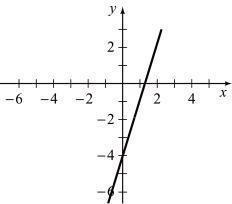
48. To graph f ( x ) = 21 x , plot points and draw a 51. To graph f ( x ) = x + 4 , plotpointsand drawa
To graph h ( x ) = 5- x , plot points and draw a
To graph g ( x ) = x 2 -1 , plot points and draw a
-2 -1 0 1 2
= x 2 - 1 3 0 -1 0 3
To graph g ( x ) = 3- x 2 , plot points and draw a smooth graph.
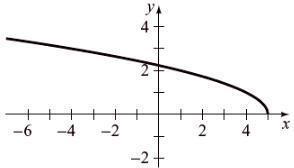
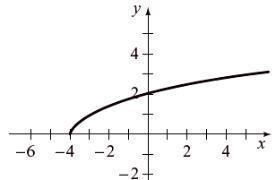

To graph f ( x ) = x - 2 , plot points and draw a
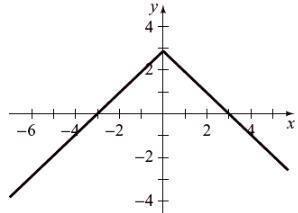
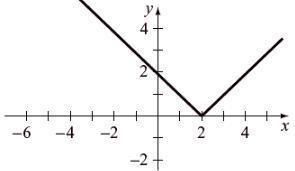
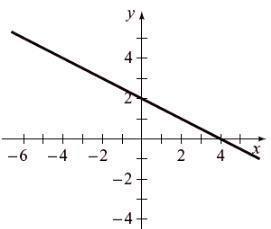
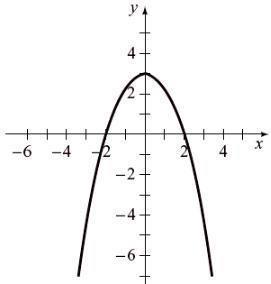
54. To graph h ( x ) = 3- x , plot points and draw a smooth graph.
To graph N ( x ) = int( x )+ x for 0 £ x £ 4 , plot points and draw a smooth graph
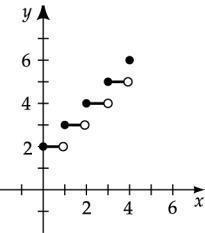
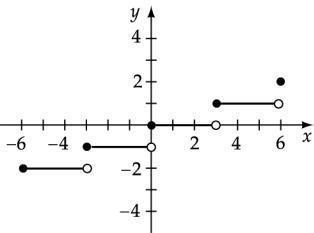

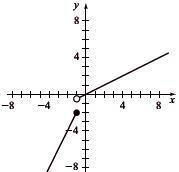
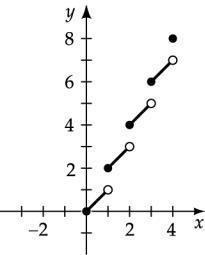
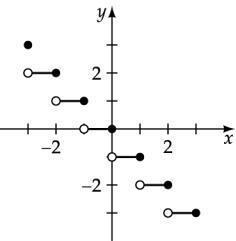
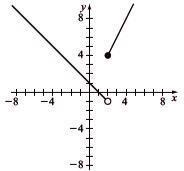
a + 2= 0 a - 7 = 0
a = -2 a = 7
Find the values of a in the domain of f ( x ) = x for Graph y =| x | for x < 1, graph y = x 2 for 1£ x < 3 , and graph y = - x + 2 for x ³ 3.
Find the value of a in the domain of f (x ) = 3x - 2 for which f (a) = 10
3a - 2 = 10 Replace f (a ) with 3a - 2 3a = 12 a = 4
Find the value of a in the domain of f ( x ) = 2-5x for which f ( a) = 7 .
2- 5a = 7 Replace f (a ) with 2-5a -5a = 5 = -1
Find the values of a in the domain of f ( x ) = x 2 + 2x - 2 for which f (a) = 1.
a 2 + 2a - 2 = 1 Replace f ( a ) with a 2 + 2a - 2 a 2 + 2a - 3 = 0 ( a + 3)( a - 1) = 0
a + 3= 0 a - 1 = 0 a = -3 a = 1
Find the values of a in the domain of ( x ) = x 2 - 5x -16 for which f (a) = -2 .
a 2 - 5a - 16 = -2 Replace f ( a ) with a 2 - 5a -16
a 2 - 5a - 14 = 0 ( a + 2)( a - 7) = 0
which f ( a) = 4 .
a = 4 Replace f (a ) with a
a = -4 a = 4
68. Find the values of a in the domain of f ( x ) = x + 2 for which f (a) = 6
a + 2 = 6 Replace f (a ) with a + 2
a + 2 = -6 a + 2 = 6
a = -8 a = 4
69. Find the values of a in the domain of f ( x ) = x 2 + 2 for which f ( a) = 1.
a 2 + 2= 1 Replace f ( a ) with a 2 + 2
a 2 = -1
There are no real values of a
Find the values of a in the domain of f ( x ) = x - 2
for which f (a) = -3
a - 2 = -3 Replace f (a ) with a - 2
= -1
There are no real values of a
71. Find the zeros of f for f ( x ) = 3x -6 ( x) = 0 3x -
72. Find the zeros of f for f ( x ) = 6 + 2x

Determine which graphs are functions
Yes; every vertical line intersects the graph in one point.
Yes; every vertical line intersects the graph in one point.
No; some vertical lines intersect the graph at more than one point.
Yes; every vertical line intersects the graph in one point.
a. Yes; every vertical line intersects the graph in one
point.
No; some vertical lines intersect the graph at more
than one point.
No; a vertical line intersects the graph at more than one point.
Yes; every vertical line intersects the graph in one point.
Determine where the graph is increasing, constant, or decreasing Decreasing on ( , 0] ; increasing on [0, )
Determine where the graph is increasing, constant, or decreasing. Decreasing on (-¥, ¥)
Determine where the graph is increasing, constant, or decreasing Increasing on (-¥, ¥)
Determine where the graph is increasing, constant, or decreasing Increasing on (-¥, 2] ; decreasing on [2, ¥)
Determine where the graph is increasing, constant, or decreasing. Decreasing on (-¥, -3] ; increasing on [-3, 0] ; decreasing on [0, 3] ; increasing on [3, ¥)
Determine where the graph is increasing, constant, or decreasing. Increasing on (-¥, ¥)
Determine where the graph is increasing, constant, or decreasing Constant on (-¥, 0] ; increasing on [0, ¥)
Determine where the graph is increasing, constant, or decreasing. Constant on (-¥, ¥)
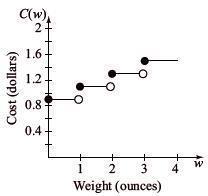
Determine where the graph is increasing, constant, or decreasing Decreasing on (-¥, 0] ; constant on [0, 1]; increasing on [1, ¥)
Determine where the graph is increasing, constant, or decreasing. Constant on (-¥, 0] ; decreasing on [0, 3] ; constant on [3, ¥)
Determine which functions from 77-81 are one-to-one.
g and F are one-to-one since every horizontal line intersects the graph at one point.
f, V, and p are not one-to-one since some horizontal lines intersect the graph at more than one point.
Determine which functions from 82-86 are one-to-one.
s is one-to-one since every horizontal line intersects the graph at one point.
t, m, r and k are not one-to-onesince some horizontal lines intersect the graph at more than one point.
a. C(2 8) = 0 90 - 0 20int(1- 2 8) 0 90- 0 20int(-1 8) 0.90-0.20(-2)
0.90 + 0.4
$1.30
a. Domain: [0, ¥)
b. T (50,020) = 0 25(50,020-35,350) + 4867 50
0 25(14,670) + 4867 50
3667 50 + 4867 50
$8535
T (123,500) = 0 28(123,500-85,650)+17,442 50
0 28(37,850) +17, 442 50
10,598+17, 442 50
$28,040 50
a. Write the width.
2l + 2w = 50 2w = 50- 2l = 25-l
b. Write the area.
A = lw = l (25-l)
A = 25l -l2
a. Write the length = 12 l d + l 4(d + l ) = 12l 4d + 4l = 12l 4d = 8l 1 2 d = l 1 l (d ) = 2 d
Find the domain Domain: [0, ¥) 1
Find the length l(8) =
Write the function.
2 (8) = 4 ft
v (t ) = 80,000- 6500t , 0 £ t £10
Write the function
v (t ) = 44,000- 4200t , 0 £ t £ 8
a. Write the total cost function. C (x ) = 5(400) + 22 80x 2000 + 22 80x
Write the revenue function R (x ) = 37 00x
Write the profit function
P (x ) = 37 00x -C (x)
37 00- [2000 + 22 80x]
37 00x - 2000- 22 80x
14 20x - 2000
Note x is a natural number
a. Write the volume function
105. Write the function
= lwh the domain of V is dependent on the domains of l, w, and h Length, width and height must be positive values 30 - 2 x > 0 and x > 0.
Thus, the domain of V is {x | 0 < x < 15}.
101. Write the function
a. Write the function.
104. Write the function.
where t is the number of hours after 12:00 noon
a. Write the function
110. Complete the table.
Chapter 2 Functions and Graphs
112.Find c.
g ( c ) = -2 c 2 + 4 c - 1 = -4 = -2c 2 + 4c + 3 = 0 -442 -4(-2)(3)
c = 2(-2)
c = -4 16+24 = -440 -4 -4
c = -4 210 -4
c = 2 10 2
113. Determine if 1 is in the range. 1 is not in the range of f ( x) , since 1 = x -1 only if x + 1 = x - 1 or 1 = -1. x +1
114. Determine if 0 is in the range.
0 is not in the range of g(x), since
0 = 1 only if (x - 3)(0) = 1 or 0 = 1. -3
115. Graph functions. Explain how the graphs are related.
117. Find all fixed points.
a 2 + 3a - 3 = a
2 + 2a - 3 = 0
a - 1)(a + 3) = 0 a = 1 or a = -3
118. Find all fixed points. = a
+ 5 = a (a + 5)
= a 2 + 5a 0 = a 2 + 4a 0 = a (a + 4)
a = 0 or a = -4
a. Write the function.
A(x ) = - 2 x 2 + 4x Complete the table.

12467
Area 3.5 6 8 6 3.5
c. Find the domain. Domain: [0, 8].
a. Write the function.
The graph of g ( x ) = 2 -3 is the graph of f ( x ) = 2
+ 2 is
the graph of f ( x ) = x shifted up 2 units
-
2
(
h
3)
x ) = x shifted 3 units to the right. The graph of

( x ) = (x + 2)2 is the graph of f ( x ) = x 2 shifted 2
units to the left.
c. Find the domain. Domain: [0, 20].
The remainder of 49 divided by 7 is 0.
Thus December 7, 1941, was a Sunday
This one is tricky Because we are finding a date in the month of January, we must use 11 for the month and we must use the previous year, which is 2019 Thus we let m = 11, d = 1, c = 20, and y = 19.
Section 2.3 Exercises
If a line has a negative slope, then as the value of y increases, the value of x decreases
If a line has a positive slope, then as the value of y decreases, the value of x decreases
The remainder of 17 divided by 7 is 3
Thus January 1, 2020, will be a Wednesday
The graph of a line with zero slope is horizontal. The graph of a line whose slope is undefined is vertical
Determine the slope and y-intercept.
y = 4x - 5 : m = 4, y-intercept: (0,–5)
Chapter 2 Functions and Graphs 6.
Determine the slope and y-intercept.
y = 3- 2x : m = -2, y-intercept: (0, 3) 7.
Determine the slope and y-intercept.
2 x 2
( x ) = 3 : m = 3 , y-intercept: (0, 0)
Determine the slope and y-intercept.
( x ) = - 1: m = 0, y-intercept: (0,–1)
Determine whether the graphs are parallel, perpendicular, or neither
= 3x - 4 : m = 3,
= - 3x + 2 : m = -3
The graphs are neither parallel nor perpendicular
Determine whether the graphs are parallel, perpendicular, or neither.
y =2 2 3 x + 1: m = - 3 ,
The graphs are parallel.
Determine whether the graphs are parallel, perpendicular, or neither
-
Find the slope.
m = 1- 4 = -3 = -3 5-(-2) 7 7
Find the slope m
2 - 0 1
= 0 - 4 = - 2
Find the slope.
m = 4- 4 =0 = 0
2-(-3) 5
Find the slope. - 7- 2 -9
m = = undefined
3-3 0
Find the slope. 0 0
0 -
m = 3- 0 = 3 = 0
m = 4- (-1) = 5
-
3 3 22. Find the slope.
Determine whether the graphs are parallel, perpendicular, or neither
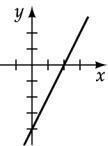
4 x ( x ) = 3 3 4 + 2 : m = 3 ,
(
The graphs are perpendicular
Find the slope.
y
m = 2 - y1 =7- 4= 3 = - 3
x2 - x1 1- 3 -2 2
Find the slope, y-intercept, and graph y = - x +1
m = –1, y-intercept (0, 1)
3
Find the slope, y-intercept, and graph y = 4 x +1
3
m = 4 , y-intercept (0, 1)
Find the slope, y-intercept, and graph y = 3
m = 0, y-intercept (0, 3)
Find the slope, y-intercept, and graph. y = -2
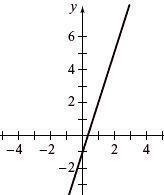

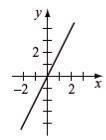

m = 0, y-intercept (0, –2)
Find the slope, y-intercept, and graph y = 2x 3
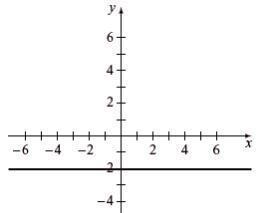
Find the slope, y-intercept, and graph y = - 2 x + 4
3
m = - 2 , y-intercept (0, 4)
m = 2, y-intercept (0, 0)
Find the slope, y-intercept, and graph. y = -3x
m = –3, y-intercept (0, 0)
Find the slope, y-intercept, and graph. y = -2 x + 3
m = –2, y-intercept (0, 3)
Find the slope, y-intercept, and graph y = 3 x -1
m = 3, y-intercept (0, –1)
Find the slope, y-intercept, and graph y = x
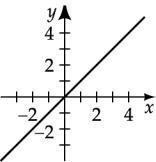
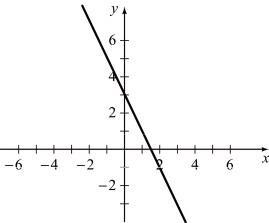
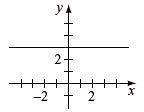
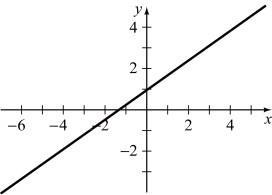
m = 1, y-intercept (0, 0)
Find the slope, y-intercept, and graph y = -x
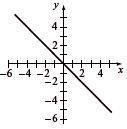
m = –1, y-intercept (0, 0)

152 Chapter 2 Functions and Graphs
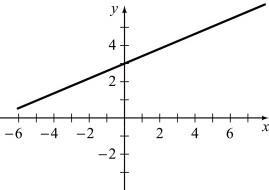
Write slope-intercept form, find intercepts, and graph
2 x + y = 5 = -2 x + 5
x-intercept (2 5 , 0) , y-intercept (0, 5)
Write slope-intercept form, find intercepts, and graph.
x - y = 4 = x - 4
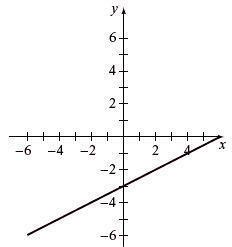
x-intercept (4, 0), y-intercept (0, –4)
Write slope-intercept form, find intercepts, and graph.
4x + 3y - 12 = 0
3y = - 4x +12 4
x-intercept (3, 0), y-intercept (0, 4)
x-intercept - 2 , 0), y-intercept (0, 3)
15
Write slope-intercept form, find intercepts, and graph
3x - 4 y = 8 - 4 y = - 3x + 8 y = 3 x - 2 4 8
x-intercept ( 3 , 0), y-intercept (0, –2) = - 3 x + 4
Write slope-intercept form, find intercepts, and graph
+ 2 y = 6 1
= - 2 x + 3
Write slope-intercept form, find intercepts, and graph
2x + 3y + 6 = 0
3y = - 2x -6 2
x-intercept (6, 0), y-intercept (0, 3) = - 3 x - 2
x-intercept (–3, 0), y-intercept (0, –2)
Write slope-intercept form, find intercepts, and graph. - 3y = 9 1 = 3 x -3
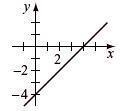
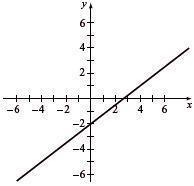
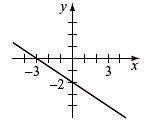
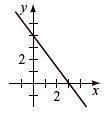

Write slope-intercept form, find intercepts, and graph.
2x - 5y = -15
5y = -2x -15 2
x-intercept (9, 0), y-intercept (0, –3) y = 5 x + 3
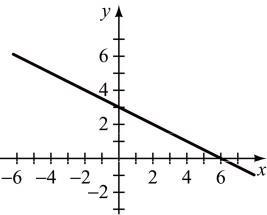
Chapter 2 Functions and Graphs
Find
Xmin = 4, Xmax = 6, Xscl=2,
= 12 2, Ymax = 2, Yscl = 2
Find the zero of f f
The x-intercept of the graph of f ( x) is (4, 0)
The x-intercept of the graph of f ( x) is (-20, 0).

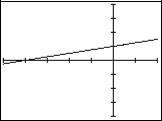
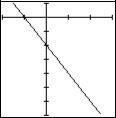
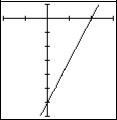
Xmin = -30, Xmax = 30, Xscl = 10,
Ymin = -10, Ymax = 10, Yscl = 1
Find the zero of f 1
The x-intercept of the graph of f ( x) is (6, 0)
Xmin = 4, Xmax = 6, Xscl=2, Ymin = 12.2, Ymax = 2, Yscl = 2
Find the zero of f.
The x-intercept of the graph of f ( x) is (–2, 0)
Xmin = 2, Xmax = 8, Xscl = 2,
Ymin = 6, Ymax = 8, Yscl = 2
Find the slope and explain the meaning = 1505-1482 =2.875 28-20
The value of the slope indicates that the speed of sound
Chapter 2 Functions and Graphs
in water increases 2 875 m/s for a one-degree Celsius increase in temperature.
Find the slope and explain the meaning
40-10
m = 100-25 = 0.4
The value of the slope indicates that the file is being downloaded at 0.4 megabytesper second.
31- 20
a. m = = 1 23-12
(
c ) - 20 = 1( c -12)
H ( c ) = c + 8
H (19) = (19) + 8 = 27 mpg
864.9-1008.1
a. m = = -35.8 2011-2007
C (t ) - 864.9 = - 35 8(t - 2011)
C (t ) = - 35 8t + 72,858 7
750 = - 35 8t + 72,858 7 - 72,108.7 = -35 8t
2014 2 » t
The debt will fall below $750 billion in 2014
a. m = 316,500 - 279, 200 =3730 2020- 2010
N (t ) - 279,200 = 3730(t - 2010)
N (t ) = 3730t - 7,218,100
300,000 = 3730t - 7,218,100
7,518,100 = 3730t
2015.6 » t
The number of jobs will exceed 300,000 in 2015.
2200- 2150
a. m = = -10 15-20
(
t )- 2200 = -10(t -15) T
(t ) = -10t + 2350
240-180
a. m = = 30
18-16
B (d )- 180 = 30(d -16)
B (d ) = 30d -300
The value of the slope means that a 1-inch increase in
the diameter of a log 32 ft long results in an increase of 30 board-feet of lumber that can be obtained from the log
B(19) = 30(19) - 300 = 270 board feet
a. m = 1640-800 60-40 = 42
E(T )-800 = 42(T -40)
E(T ) = 42T -880
The value of the slope means that an additional 42
acre-feet of water evaporate for a one F increase in temperature.
E(75) = 42(75) - 880 = 2270 acre-feet
Line A represents Michelle.
Line B represents Amanda.
Line C represents the distance between Michelle and Amanda.
1 - 9
a. mAB = 8 - 6 = -4 F
1 - 9
mAB = 8 - 6 = -4 F
m -4-5 =9 F =
DE 5-6
The temperature changed most rapidly between points D and E.
c. The temperature remained constant (zero slope)
between points C and D.
80.5-19.9
The value of the slope means that the temperature is 81. a. m = 0-65 » -0 9323
decreasing at a rate of 10 F per minute.
T (180) = -10(180)+ 2350 = 550 F
After 3 hours, the temperature will be 550 F.
- 80.5 = - 0 9323(x - 0) y
= - 0.9323x + 80.5
b. y = - 0 9323(25) + 80 5 = 57 19 » 57 years
a. m = 75.5 -17.2 65 » -0 8969 0-
- 75.5 = -0.8969( x - 0) y = - 0 8969 x + 75.5
b. y = - 0.8969(25) + 75.5 = 53.08 » 53 years
Determine the profit function and break-evenpoint.
P (x ) = 92 50x - (52x +1782)
P (x ) = 92 50x - 52x -1782
P (x ) = 40 50x -1782
40.50x - 1782 = 0 40.50x = 1782
x = 40.50
a. C(0) = 8(0) + 275 = 0 + 275 = $275
C(1) = 8(1)+ 275 = 8+ 275 = $283
C(10) = 8(10)+ 275 = 80+ 275 = $355
The marginal cost is the slope of C (x ) = 8x + 275, which is $8 per unit.
a. R(0) = 210(0) = $0
R(1) = 210(1) = $210
R(10) = 210(10) = $2100
The marginal revenue is the slope of R (x ) = 210x, 1782
which is $210 per unit.
a. C (t ) = 19,500.00 + 6.75t
x = 44, the break-even point
Determine the profit function and break-evenpoint.
P (x ) = 124x - (78.5x + 5005)
P (x ) = 124x - 78.5x -5005
P (x ) = 45.5x -5005
45 5x - 5005 = 0 45 5x = 5005 x = 5005 45.5
x = 110, the break-even point
Determine the profit function and break-evenpoint.
P (x ) = 259x - (180x +10,270)
P (x ) = 259x - 180x -10,270
P (x ) = 79x -10,270
79x - 10,270 = 0
79x = 10,270
R (t ) = 55.00t
P (t ) = R (t )-C (t)
P (t ) = 55 00t - (19,500 00 +
6 75t) P (t ) = 55 00t - 19,500 00-
6 75t P (t ) = 48 25t -19,500 00
48.25t = 19,500.00 = 19,500 00
48 25
t = 404 1451 days » 405 days
m = 117,500-98,000= 19,500 =6.5 35,000-32,0003000
P (s )- 98,000 = 6 5(s -32,000) P (s
) = 6 5s - 208,000 + 98,000 P (s
) = 6 5s -110,000
P(50,000) = 6 5(50,000)-110,000
x = 10,270 325,000-110,000 79
x = 130, the break-even point
Determine the profit function and break-even point.
P (x ) = 14,220x - (8010x +1,602,180)
P (x ) = 14,220x - 8010x -1,602,180
P (x ) = 6210x -1,602,180
6210x - 1,602,180 = 0 6210x = 1,602,180
x = 1,602,180 6210
x = 258, the break-even point
$215,000
Let 6 5s - 110,000 = 0 Then
6 5s = 110,000 110,000 s = » 16,924 subscribers
6.5
The equation of the line through (0,0) and P(3,4) 4 has slope 3 .
The path of the rock is on the line through P(3,4) with
158 Chapter 2 Functions and Graphs
4 y = - 4 x + 4
The point where the rock hits the wall at y = 10 is the 3 point of intersectionof y = - 4 25 x + 4 and y = 10
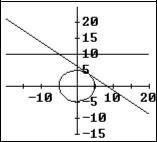
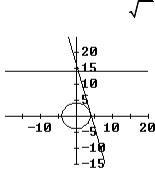
3 4 x + 25 4 = 10 -3x + 25 = 40 - 3x = 15 x = -5 feet
Therefore the rock hits the wall at (-5, 10)
The x-coordinate is –5.
The equation of the line through (0,0) and
P( 15, 1) has slope 1 .
The path of the rock is on the line through
P( 15, 1) with slope - 15 so y - 1 = - 15(x - 15) y - 1 = - 15x +15
The point of impact with the wall at y = 14 is the point of intersection of y = - 15x +16 and y = 14 intersect.
The x-coordinate is 15 or approximately
h = 0 01 so
Q (1+ h, [1 + h ]2 + 1) = Q(1.01, 1.012 +1) Q(1 01, 2 0201)
m = 2 0201- 2 = 0 0201 =2.01 1.01-1 0.01
As h approaches 0, the slope of PQ seems to be approaching2. x1 = 1, y1 = 2, x2 = 1+ h, y 2 = [1+ h]2 +1
The slope of the line through (3, 9) and (x, y) 15 y - 9 15 is 2 , so x - 3 = 2 .
The slope of the line through (3, 2) and (x, y) is
x + 64 = 9x 2 + 42x + 49
As h approaches 0, the slope of PQ seems to be approaching
